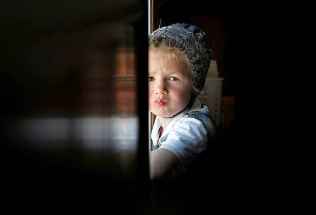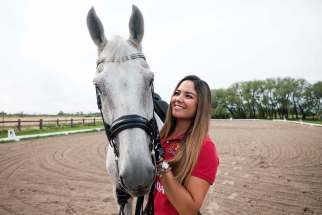They don’t make ’em like that anymore Classic rom-com Sleepless in Seattle still resonates 25 years later
Read this article for free:
or
Already have an account? Log in here »
To continue reading, please subscribe:
Monthly Digital Subscription
$1 per week for 24 weeks*
- Enjoy unlimited reading on winnipegfreepress.com
- Read the E-Edition, our digital replica newspaper
- Access News Break, our award-winning app
- Play interactive puzzles
*Billed as $4.00 plus GST every four weeks. After 24 weeks, price increases to the regular rate of $19.00 plus GST every four weeks. Offer available to new and qualified returning subscribers only. Cancel any time.
Monthly Digital Subscription
$4.75/week*
- Enjoy unlimited reading on winnipegfreepress.com
- Read the E-Edition, our digital replica newspaper
- Access News Break, our award-winning app
- Play interactive puzzles
*Billed as $19 plus GST every four weeks. Cancel any time.
To continue reading, please subscribe:
Add Winnipeg Free Press access to your Brandon Sun subscription for only
$1 for the first 4 weeks*
*$1 will be added to your next bill. After your 4 weeks access is complete your rate will increase by $0.00 a X percent off the regular rate.
Read unlimited articles for free today:
or
Already have an account? Log in here »
Hey there, time traveller!
This article was published 29/06/2018 (2629 days ago), so information in it may no longer be current.
Sleepless in Seattle, a classic romantic comedy of the 1990s, turned 25 last week. Rewatching this appealing — and very influential — film in 2018 offers a lot of nostalgia and a few new insights.
(Note: There are minor spoilers ahead for Sleepless, though if you’ve seen any other rom-com in the past quarter-century, they probably won’t be that surprising.)
SOMETHING OLD, SOMETHING NEW

Sleepless, directed and co-scripted by Nora Ephron, helped to solidify Hollywood’s contemporary rom-com template.
Meg Ryan, operating at peak sunniness, plays Annie, a Baltimore journalist with a shabby chic apartment. Tom Hanks, all wry, warm charm, is Sam, a recently widowed Seattle architect with a young son.
Annie’s best-friend sidekick is the no-nonsense Becky (Rosie O’Donnell), while Sam’s sounding board is the weary Jay (Rob Reiner), whose job is to tell Sam what it’s like “out there” in the dating world. (It’s 1993, so there’s a lot of tiramisu.)
Annie also has a fiancé named Walter (Bill Pullman), whose fate is sealed when Sam ends up on a call-in radio show, talking with such tenderness and feeling about his late wife that women all over America, including Annie, promptly fall in love with him.
This fairly standard rom-com structure is still around today (for better or for worse). The genre-stretching trick with Sleepless is that the would-be lovers meet cute — but only in the final scene.
SO 1990s
Oh, it’s a time of big coats and big hair and landlines and letters with stamps. At one point, Annie, who’s very sweet but also — in hindsight — a little stalker-ish, uses some clunky pre-Google tech on her work computer to track down Sam after his radio appearance.
And everyone is heartbreakingly young, including Gaby Hoffmann (now a semi-adult on Transparent), who plays a precociously sardonic eight-year-old.
WE HEART WALTER
Poor, dear Walter, who starts out as the designated right guy but turns out to be the wrong guy. One of the heartening things about Sleepless’s 25th anniversary is how many rewatchers now realize Walter is a catch, and not just because of Pullman’s sexy, sideways, self-deprecating smile.
Walter is decent and kind, which are actually such good qualities that the script must afflict him with allergies. (“I’m allergic to everything,” he says brightly when he’s being introduced to Annie’s parents.)
“I don’t deserve you, Walter,” Annie finally says, which many Team Walter supporters will confirm. Pullman will eventually play the wrong guy who turns out to be the right guy in While You Were Sleeping. Meanwhile, Walter should save that engagement ring for someone who really loves him in all his sneezy sweetness.
SUPER META
Annie initially designates “real love” as solid, sensible, practical and predictable (or, you know, Walter-ish), but finds herself yearning for magic.
As Becky says, “You don’t want to be in love. You want to be in love in a movie.”
There’s lots of very meta chat about the differences between real love and cinematic love, and about how films have shaped — or possibly warped — our expectations of romance and marriage. Ephron tiptoes expertly between hope and experience, sweetness and cynicism in what is essentially a movie-long commentary on movie-watching.

A GENRE TO REMEMBER
The story’s specific cinematic touchstone — including that top-of-the-Empire-State-building ending — is the 1957 weepie An Affair to Remember.
Every woman in Sleepless starts to cry when watching or even thinking about Affair, prompting a scene in which two guys pretend to get all choked up about the ending of The Dirty Dozen.
Sleepless’s Affair obsession seems to underline the frequent film-fan complaint that “they don’t make ’em like that anymore.” In 2018, we’re saying the same thing about Sleepless.
Sleepless supplied a temporary boost for a genre that has since dwindled and diminished, both creatively and commercially. In those increasingly common “Is the Rom-com Dead?” think pieces, some commentators cite cultural changes. There aren’t that many barriers to people having sex these days, for example, which makes it tricky for a genre that relies on obstacles. Others see shifts in the movies themselves, which have become coarser and meaner, turning the male-female dynamic from sparkling romantic repartee to mean-spirited gender warfare.
But this decline is also because movies about love have been dismissed as “chick flicks,” an idea that Ephron — in her meta way — challenges in the film. Sleepless in Seattle approaches love with a light touch but a serious heart, which might be why it resonates 25 years on.
alison.gillmor@freepress.mb.ca

Studying at the University of Winnipeg and later Toronto’s York University, Alison Gillmor planned to become an art historian. She ended up catching the journalism bug when she started as visual arts reviewer at the Winnipeg Free Press in 1992.
Our newsroom depends on a growing audience of readers to power our journalism. If you are not a paid reader, please consider becoming a subscriber.
Our newsroom depends on its audience of readers to power our journalism. Thank you for your support.










